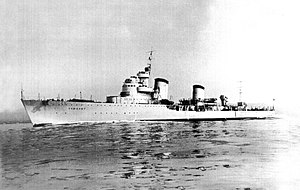Tashkent-class destroyer
 Tashkent on her builder's sea trials, 1937
| |
| Class overview | |
|---|---|
| Name | Tashkent class |
| Operators | |
| Preceded by | Leningrad class |
| Succeeded by | Kiev class |
| Built | 1937–1940 |
| In service | 1940–1942 |
| Planned | 4 |
| Completed | 1 |
| Cancelled | 3 |
| Lost | 1 |
| General characteristics (as designed) | |
| Type | Destroyer leader |
| Displacement | 2,840 long tons (2,890 t) (standard) |
| Length | 139.7 m (458 ft 4 in) ( o/a ) |
| Beam | 13.7 m (44 ft 11 in) |
| Draft | 3.7 m (12 ft 2 in) |
| Installed power |
|
| Propulsion | 2 shafts; 2 geared steam turbines |
| Speed | 42.7 knots (79.1 km/h; 49.1 mph) |
| Range | 5,030 nmi (9,320 km; 5,790 mi) at 20 knots (37 km/h; 23 mph) |
| Complement | 250 |
| Armament |
|
The Tashkent class (officially known as
Design and description
Unsatisfied with the Leningrad-class destroyer leader, the Soviets decided that they needed foreign design assistance around 1934–1935. The French were not willing to share ship plans so the Soviets turned to Italy, based on their earlier experience with the Italians during the preliminary design work for the Kirov-class cruisers. They requested designs for a high-speed destroyer leader from three Italian shipbuilders and accepted the submission by Odero-Terni-Orlando (OTO) in September 1935. They would build the lead ship, named Tashkent, in their Livorno shipyard, and provide assistance for the Soviets to build others in their own shipyards. Three other ships were ordered, although the only ship to receive a name was Baku, before they were all cancelled due to difficulties with adapting the Italian design to Soviet shipbuilding practices.[1] A total of eleven ships in the class were planned: three for the Baltic Fleet, two for the Black Sea Fleet, two for the Northern Fleet and four for the Pacific Fleet.[2]
The Tashkent-class ships had an
The ships had a pair of geared
Armament and fire-control

Tashkent's main armament was intended to consist of six 50-
The Tashkents carried nine 533 mm (21 in)
Tashkent was equipped with a gunnery
Modifications
During a brief refit in February 1941, the three B-2LM turrets were installed. At the same time the 45 mm guns were replaced by an equal number of fully automatic 37-millimeter (1.5 in) 70-K AA guns.[10] The gun had a range of 4,000 meters (4,400 yd) from its 0.732-kilogram (1.61 lb) fragmentation shells that were fired at a muzzle velocity of 2,900 ft/s (880 m/s). They had a maximum elevation of +90° and a rate of fire of 160–180 rounds per minute.[8]
A twin-gun 39-K mount for 76.2-millimeter (3 in) 34-K AA guns was fitted on her stern while Tashkent was under repair on 31 August; it had been originally intended for the destroyer Ognevoy-class destroyer Ognevoy which was still under construction.[10] The 34-K guns could elevate between -5° and +85° and had a rate of fire of 15–20 rounds per minute. Their muzzle velocity of 801 meters per second (2,630 ft/s) gave their 26-pound (11.9 kg) high-explosive shells a maximum horizontal range of 14,640 meters (16,010 yd) and an effective ceiling of 6,500 meters (21,300 ft).[8]
- Original drawings by Odero-Terni-Orlando Shipyards, Livorno, 1936
-
Right elevation
-
Plan
-
Longitudinal section
Ships
| Name[11] | Builder[11] | Laid down[11]
|
Launched[5] | Entered service[2] | Fate |
|---|---|---|---|---|---|
| Tashkent | OTO, Livorno, Italy | 11 January 1937 | 28 December 1937 | 22 October 1939 | Sunk by aircraft, 2 July 1942 [5] |
| Baku ( yard number 511)
|
Zavod No. 190 (Zhdanov), Leningrad | Cancelled, 1940[11] | |||
| Unnamed (yard number 512) | |||||
| Unnamed | Marti South, Nikolayev | ||||
Service
During the Siege of Odessa, Tashkent escorted a transport to
References
- ^ Rohwer & Monakov, pp. 45–46
- ^ a b c d Budzbon, Radziemski & Twardowski, p. 103
- ^ a b Budzbon, p. 329
- ^ a b c Platonov, p. 140
- ^ a b c Hill, p. 44
- ^ Platonov, pp. 140–141
- ^ a b Yakubov & Worth, p. 103
- ^ a b c Yakubov & Worth, p. 104
- ^ Platonov, p. 140; Wright, p. 360
- ^ a b Budzbon, Radziemski & Twardowski, p. 104
- ^ a b c d Rohwer & Monakov, p. 232
- ^ Platonov, pp. 141–142; Wright, pp. 349–350, 352, 358–360
Bibliography
- Budzbon, Przemysław (1980). "Soviet Union". In Chesneau, Roger (ed.). Conway's All the World's Fighting Ships 1922–1946. Greenwich, UK: Conway Maritime Press. pp. 318–346. ISBN 0-85177-146-7.
- Budzbon, Przemysław; Radziemski, Jan & Twardowski, Marek (2022). Warships of the Soviet Fleets 1939–1945. Vol. I: Major Combatants. Annapolis, Maryland: Naval Institute Press. ISBN 978-1-68247-877-6.
- Hill, Alexander (2018). Soviet Destroyers of World War II. New Vanguard. Vol. 256. Oxford, UK: Osprey Publishing. ISBN 978-1-4728-2256-7.
- Platonov, Andrey V. (2002). Энциклопедия советских надводных кораблей 1941–1945 [Encyclopedia of Soviet Surface Ships 1941–1945] (in Russian). Saint Petersburg: Poligon. ISBN 5-89173-178-9.
- ISBN 1-59114-119-2.
- Rohwer, Jürgen & Monakov, Mikhail S. (2001). Stalin's Ocean-Going Fleet: Soviet Naval Strategy and Shipbuilding Programs 1935–1953. London: Frank Cass. ISBN 0-7146-4895-7.
- Wright, Christopher C. (1994). "The Fate of the Tashkent". Warship International. XXXI (4): 348–360. ISSN 0043-0374.
- Yakubov, Vladimir & Worth, Richard (2008). "The Soviet Project 7/7U Destroyers". In Jordan, John & Dent, Stephen (eds.). Warship 2008. London: Conway. pp. 99–114. ISBN 978-1-84486-062-3.
Further reading
- Afonsin, Nikolay N. (2008). Lider "Tashkent" [Leader "Tashkent"]. Midel-frame (in Russian). Vol. 15. Saint Petersburg: Gangut. ISBN 978-5-85875-070-3.
- Kachur, Pavel (2008). "Гончие псы" Красного флота. "Ташкент", "Баку", "Ленинград" [Hounds of the Red Fleet: Tashkent, Baku, Leningrad] (in Russian). Moscow: Yauza/Eksmo. ISBN 978-5-699-31614-4.



